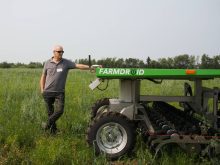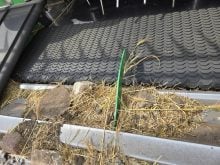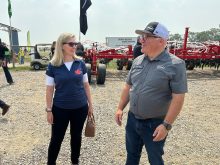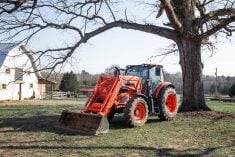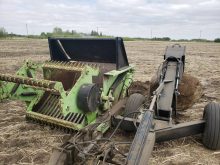Fifteen more feet required | Grower says a 165-foot boom would better fit the dimensions of his quarter-section fields
FARGO, N.D. — Ron Sylte is ready to up-size his year-old 150 foot self-propelled Sprayflex to a more convenient 165 foot sprayer.
The combination of a 3,100 US gallon tank and 150 foot boom width allows Sylte to spray 600 acres in four to five hours non-stop.
He seeds 10,000 acres, but many of the fields are managed as quarter sections. And that’s where the 150 foot boom width becomes a mathematical nuisance.
“When I’m covering 150 feet per swath in-crop, I always finish at the wrong end of a quarter section field,” says Sylte.
Read Also

Final crop reports show strong yields, quality
Crops yielded above average across the Prairies this year, and quality is generally average to above-average.
“150 feet doesn’t divide very well into a field that’s a square half mile by a half mile.”
Although Sylte concedes that his sprayer is already the biggest in the world, he stills wants to up-size to 165 feet so the math works properly on quarter section fields.
“If I can get the guys at Sprayflex to build me a sprayer with a 165 foot boom, then we’ll be all set for efficient spraying,” he said.
“My brother and I run the whole farm. We don’t have any hired help, so we look for efficiency in everything we do.”
High wages in the oil fields of western North Dakota are only a stone’s throw from their farm, making it next to impossible for them to attract anyone capable of operating equipment.
As a result, Ron and his brother analyze every decision to make sure every change increases their efficiency.
The big Sprayflex is a good example. They took delivery of the new machine last spring and put 25,000 acres on it before fall spraying wrapped up three months ago.
Their north farm is 24 kilometres from the home yard, while their south farm is 10 km away. They could feed a sprayer with their 6,000 gallon tanker semi if they had a reliable hired hand, but they have no choice but to put up with the inconvenience of driving the Sprayflex back to the yard for fills.
Sylte said it’s not so bad because he can drive the sprayer on the road at a comfortable 45 m.p.h. High-wheel sprayers, on the other hand, can put the operator into a white knuckle situation, even at speeds below 35 m.p.h.
Efficiency would be better if he used the big tanker as a tender, but that’s not an option.
Instead, he uses the tanker to haul spray-quality water back to his yard. He buys water from a local irrigation well or from the city of Williston, N.D. Back at the yard, he mixes chemical into the Sprayflex tank as he fills.
Their quest for efficiency also includes operator comfort and operating costs.
“I can spray my first 600 acres of the day in four or five hours. I can do that twice a day and feel pretty good. We can do it three times a day, but then that’s a pretty big day,” he said.
“The main factor here is that I have to stay a few steps ahead of the seed drill. Another factor is cost of diesel fuel. In a normal trip to the field and back, spraying 600 plus acres, I burn less than 40 gallons of diesel. You’ll never do that with any brand high wheel sprayer.”
Sylte thinks the hydrostatic drive used on most sprayers consumes too much fuel and allows the machines to get stuck more often than mechanical drive sprayers.
As well, getting stuck with hydrostatic drive burns out hydraulic drive motors.
Sylte’s special order 3,100 gallon truck sprayer with 150 foot aluminum boom isn’t his first Sprayflex.
“I’ve had truck sprayers for 20 years now. In 40 years of spraying, this new Sprayflex is the best ride I’ve ever had,” he said.
“I bought my first Marflex (now Sprayflex) truck sprayer about 15 years ago. Because of the weight factor, these truck sprayers give me greater tank capacity than a high wheel sprayer.”
Sylte said his previous Sprayflex was a 2,000 gallon unit with a 120 foot boom and single rear axle. It was the biggest sprayer Sprayflex had built.
With 25,000 acres under his belt, he said the new 150 foot machine handled well.
“We saw very little boom bounce, which was a surprise for such a wide boom,” he said.
“We installed a Raven boom height control. It told us that the boom remained relatively level throughout all our spraying. We’re in no-till and some minimum-till. We have a JD 1835 with hoe type openers on nine-inch spacing, so our fields can be pretty rough sometimes, but that didn’t seem to bother the 150 foot boom. Our screen didn’t show any significant bounce, even at our normal spray speed of 15 to 16 m.p.h. and higher.”
Sylte said a Sprayflex with twin screw differentials at 150 or 165 foot booms and a 3,100 gallon tank has to be the ultimate sprayer for big-acre producers who grow small grain cereals.
“It has potential for one man to spray 1,800 acres in a long day and stay ahead of the seeding rig.”
He said all that weight and extended leverage at the boom tips haven’t been a problem in wet conditions.
“When we started this project, I talked to the guys at Sprayflex about adding a drive system to the front, but that’s a deep expenditure of $20,000 or more no matter how you do it,” he said.
“We have full lock on both rear differentials. I only engaged it once this year (2012) when I was pulling out of a ditch. It picked the front tires right off the ground. So I would say we get plenty traction and torque transfer from those four rear tires. Right now, I don’t think we need front assist.”
For more information, contact Sylte at 701-570-4851 or visit www.sprayflexsprayers.com.




